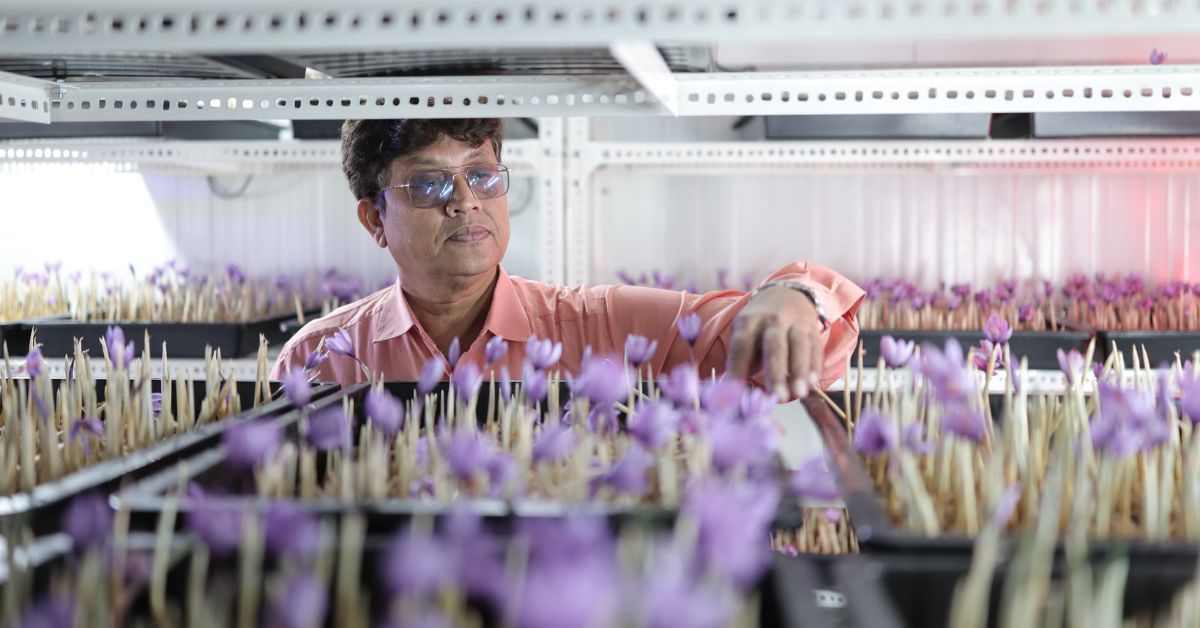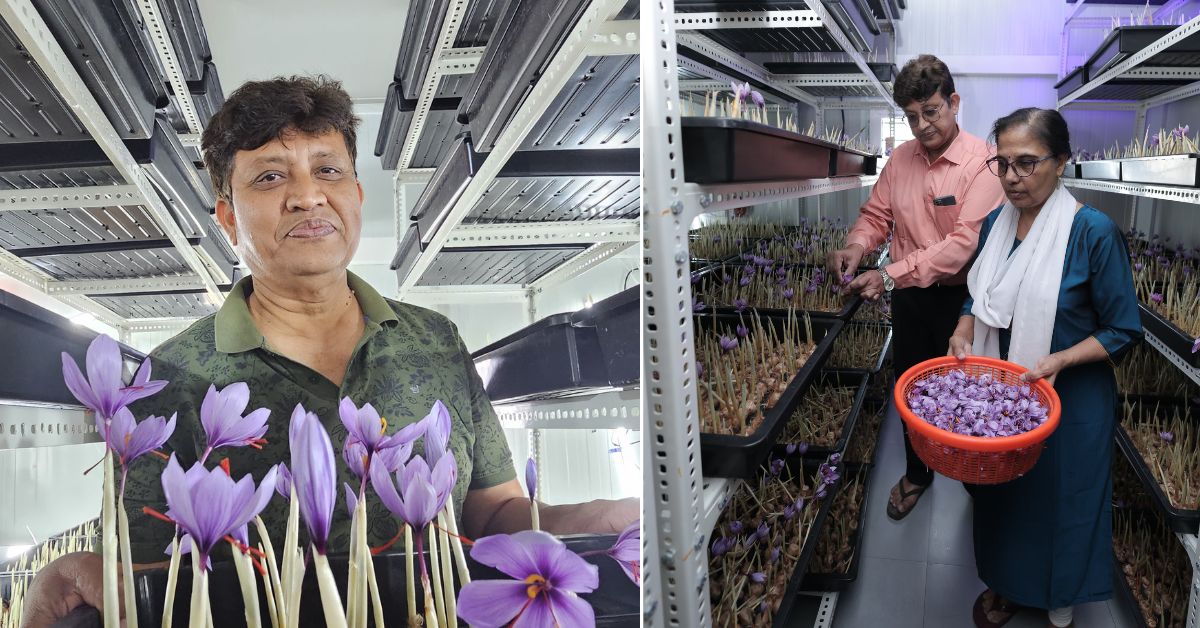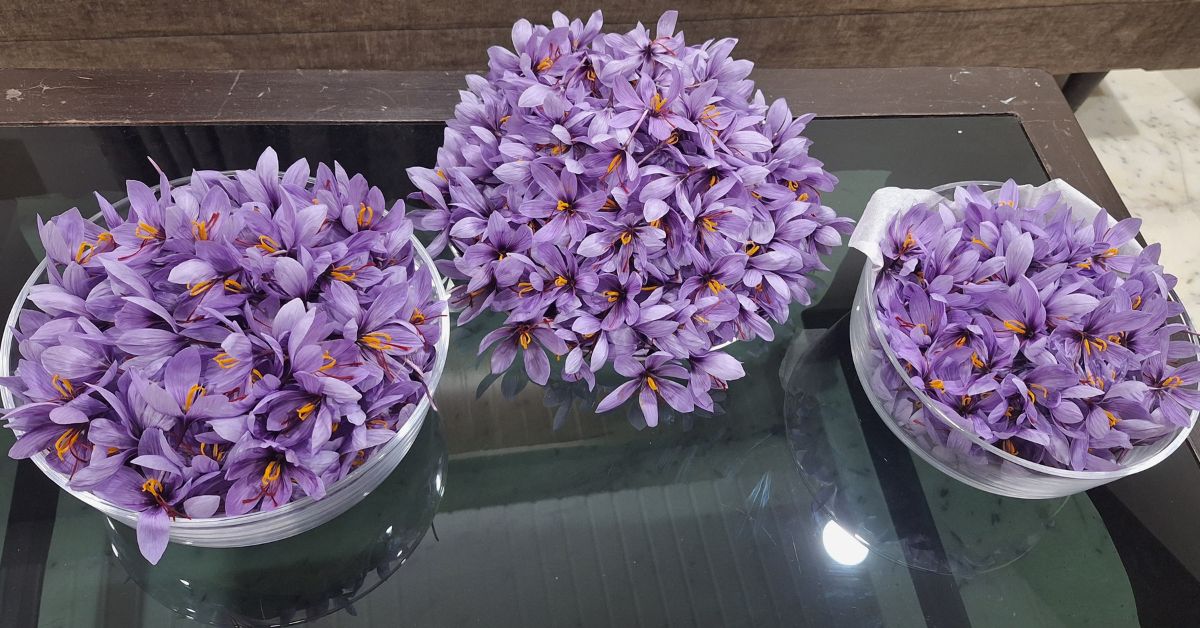Inspired by Kashmir, This Man Grew Saffron at Home in Indore — His First Harvest Earned Him Rs 3 Lakh
A family vacation to the picturesque valleys of Kashmir was all it took. As Anil Jaiswal traversed from the bustling streets of Srinagar to the tranquil saffron fields of Pampore during his 2023 vacation, he stumbled upon a vibrant tapestry of purple blooms that piqued his curiosity.
These were the famous saffron fields, their richness embedded deeply in the purple petals that danced in the cool mountain breeze of the valley.
Intrigued by its allure, Anil and his family couldn’t resist stopping to learn more about this exotic spice that thrives largely in the unique, cool climate of Kashmir. “We spoke to local farmers to learn the nuances of saffron cultivation, considered to be the pride of Kashmir,” he adds.
This experience turned into a life-altering experience for Indore-based Anil. The 59-year-old, who previously held a prestigious three-decade career in engineering and the pharmaceutical industry, found himself enchanted by the beauty and exclusivity of Kashmiri saffron. “The vibrant purple flowers with their delicate stigmas were a spectacle to behold,” he recalls.
Fueled by curiosity and a natural affinity for agriculture, Anil pondered, “Could saffron be grown in Indore?”
 This venture is not just a retirement plan for Anil but also a lucrative business that brings a part of Kashmir to their Indore home.
This venture is not just a retirement plan for Anil but also a lucrative business that brings a part of Kashmir to their Indore home.
This question lingered in his mind even after he returned home, and it wasn’t long before he delved deep into research, exploring the possibility of replicating these conditions in his city.
With a rich agricultural background, Anil was well-equipped to pursue this venture. The son of a farmer, he had spent his childhood tending to crops. He even practiced floriculture on the outskirts of his home in Indore. Leveraging this vast experience, he designed a meticulous plan to launch an indoor saffron farm.
A dream seeding: from curiosity to concrete plans
To recreate Kashmir’s unique climate, Anil discovered the potential of aeroponics for indoor saffron cultivation. Armed with knowledge from experts and scholarly books, he transformed a vacant 320 square feet room on the first floor of his home into a sophisticated indoor farm.
His investment of Rs six and a half lakh for the setup included light-emitting device setup, puff panels, chillers, humidifiers, and exhaust fans to maintain optimal temperature and humidity. Anil complemented these with a five-kilowatt solar panel to ensure a sustainable power supply and align energy costs close to zero.
 The couple manages farm operations, from nurturing the bulbs to precise environmental control.
The couple manages farm operations, from nurturing the bulbs to precise environmental control.
In September 2024, Anil procured one tonne of saffron bulbs for Rs eight lakh from Pampore. “Of this, we could use 700 kg that met the criteria for cultivation. It is advised to grow saffron bulbs weighing seven grams; otherwise, it wouldn’t result in flowering. We nurtured the remaining bulbs for the next cycle,” he explains.
Every detail of Anil’s indoor farm is tailored to replicate the conditions of a Kashmiri saffron field. From regulating temperatures between eight to 25 degrees Celsius to maintaining humidity levels, every parameter was fine-tuned to perfection.
As the saffron bloomed, Anil says, stringent hygiene practices were implemented, akin to intensive care cleanliness standards. “We wash our hands with 70 percent Isopropyl Alcohol (IPA) solution (a disinfectant) and we wear hand gloves and protective gear before entering the indoor farm. This prevents any possible contamination or fungal growth in saffron bulbs,” he shares.
He meticulously regulates carbon dioxide levels, light exposure, and bulb hygiene to ensure a thriving crop.
By November, his efforts bore fruit, as he proudly harvested 600 grams of saffron. Following the harvest, he dried the delicate red stigmas and ensured their safe storage to prevent fungal growth. Selling it at Rs 500 per gram, Anil reaped a substantial Rs three lakh from his first yield.
 The couple also enhances their homemade sweets with homegrown authentic saffron.
The couple also enhances their homemade sweets with homegrown authentic saffron.
Brought the farm home
Anil shares that his wife, Kalpana Jaiswal, is integral to their daily operations, particularly excelling in meticulous attention to detail. As part of their commitment, they recreate the natural habitat of saffron with utmost precision, even incorporating the soothing bird songs reminiscent of Kashmir’s landscapes.
Kalpana orchestrated operations with seamless precision, from nurturing bulbs to the precise timing of temperature, watering, and their timely harvest. Sharing her experience, she says, “When we visited Kashmir, the beauty of the saffron fields captivated us. We wanted to bring a piece of that charm back home. The excitement of harvesting our own saffron made it worthwhile. The quality difference is striking; we’ve come to realise much of what we previously used was not authentic. Lab tests confirmed our saffron’s purity — just two strands turn dishes a rich golden hue, unlike the quick, artificial-looking colour of market-bought saffron.”
“Now, our homemade sweets are enhanced with our own authentic saffron. It’s wonderful to have brought a slice of Kashmiri essence to our little home in Indore,” she adds.
Anil, too, is immensely satisfied with the results. “It’s a long-term business of long-term profits,” he notes, emphasising the patience required in the initial years. “By merging traditional farming wisdom with modern technology, we have crafted a sustainable, lucrative venture within our own home. Earlier, I would go 25 km away to tend to my floriculture farm. Now, I have brought the farm to my home itself. This venture is part of my retirement plan. It offers me financial security while keeping me engaged,” he adds.
All images courtesy Anil Jaiswal
News